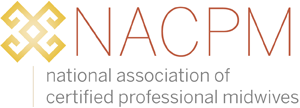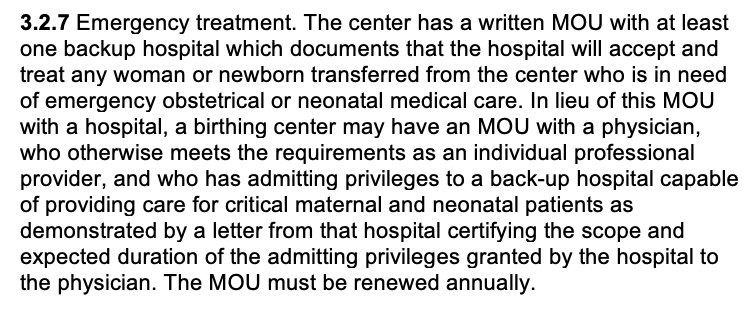Gap Analysis of TRICARE Birthing Centers Policy to CABC Accreditation Standards
The purpose of this website is to highlight the areas of TRICARE policy that are supported and enhanced by CABC accreditation standards. By hovering over the TRICARE policy, you will see the specific aligned CABC standard. Since the TRICARE policy is overdue for revision, NACPM completed this gap analysis and offered suggested language changes. NACPM’s analysis of the comparison of the TRICARE policy to the CABC standard is featured to the right of the TRICARE policy. Of course, NACPMs' suggested changes are not the only way to align these two benchmarks. However, if these or similar changes were made, TRICARE contracts would be more straightforward because accreditation would ensure adherence to TRICARE policy.
TRICARE Policy Manual 6010.63-M, April 2021 NACPM Analysis
Although many of the Standards and Attributes evaluated by the Commission for the Accreditation of BIrth Centers are similarly covered by other accrediting bodies, the CABC is the only accrediting body with expertise in the safety and quality of care for freestanding birth centers and alongside midwifery units. It uses the Standards for BIrth Centers as developed and maintained by the American Association of BIrth Centers (AABC).
Although many of the Standards and Attributes evaluated by the Commission for the Accreditation of Birth Centers are similarly covered by other accrediting bodies, the CABC is the only accrediting body with expertise in the safety and quality of care for freestanding birth centers and alongside midwifery units. It uses the Standards for Birth Centers as developed and maintained by the American Association of Birth Centers (AABC).
TRICARE 3.1.3 - 3.1.4.5 These policies list acceptable accrediting organizations (including Commission for the Accreditation of Birth Centers, CABC) and the processes through the Medical Benefits and Reimbursement Section (MB&RS) for recognition. The section content includes information that would be part of the contract dictated by TRICARE, and do not serve a purpose in this analysis.
Sections 3.1.4.2 - 3.1.4.3 are proven through accreditation. Financial and organizational record management is viewed as well as evaluations and inspections are conducted during the new and renewal accreditation processes.
Section 3.1.4.4-3.1.4.6. These terms are dictated by TRICARE in the contract with the birth center.
Environmental Standards for CABC far exceed those of TRICARE policy.
The accreditation requirement exceeds TRICARE policy requirements. The CABC Requires extensive planning and implementation of procedural requirements in the following areas; Planning, Governance, Administration, Human resource requirements for quality control and cohesive professional standards, Clinical skills requirements, the maintenance of Health records, Quality evaluation and Improvement, Philosophy of care requirement, and honoring clients rights.
CABC requires the utilization of ‘shared decision making’ and informed choice. Expansion of the requirements can be found in a section titled “Client Rights”. The Midwifery Model of Care utilizes a collaborative care structure, where patients/clients, are considered a valuable part of the decision making process. “Shared decision making” is a corner stone to the birth center model of care and core requirement to accreditation.
Beneficiary care. Each woman admitted into an accredited birth center is cared for by or under the direct supervision of professional staff licensed to practice their profession in the jurisdiction of the birth center who is otherwise eligible as an individual professional provider. Majority of birth centers are Midwife led facilities (over 99%). Of those, over 70% are staffed with CPMs working alongside CNMs. Over 50% of the birth centers available are staffed by CPMs alone. If the goal is to increase access to birth centers as a low cost, high value care option then it is imperative to expand coverage to include CPMs.
Medical direction. The center has an established consultation, collaboration, or referral system to meet the needs of a mother or baby outside the scope of birth center practice in both emergency and non-emergency circumstances. Given the health care availability and licensing variation across states, accreditation is the best mechanism for ensuring that adequate medical direction for NON routine consultation OR emergency care with an OB GYN and Pediatrician is available for birth center clients.
Emergency treatment. The center has a written policies and procedures that details at least one backup hospital which will accept and treat any woman or newborn transferred from the center who is in need of emergency obstetrical or neonatal medical care.
Emergency medical transportation. The center has agreements and/or written policies and procedures that details at least one ambulance service which documents that the ambulance service is routinely staffed by qualified personnel who are capable of the management of critical maternal and neonatal patients during transport and which specifies the estimated transport time to each backup hospital with which the center has arranged for emergency treatment.
CABCs accreditation process ensures all providers and staff have the knowledge and training required of their position. The standard includes provisions requiring specific additional evidence of knowledge in the areas of physiologic birth (natural birth) and chest/breastfeeding. The standard requires the HR department to maintain records of each team member’s qualifications.
The CABC Standard 5 goes beyond the policy description for medical records listed within TRCIARE. The Standard includes requirements for extensive charting [including informed consent], specifies security of PHI, and accessibility of Patient information with transfer providers.
Requirement of processes to be in place to review all sentinel events. The Standard is detailed and captures all points of data and quality assurance.
Comparatively, the accreditation process for quality assurance is more extensive than the requirements of the TRCIARE policy.
Accreditation requires the formulation of an HR Dept. and the maintaining of staff to handle responsibilities of that department and others. Staff that includes midwives and others complete daily tasks such as: daily operations, administration, patient health records, quality assurance and improvements, clinic care, data collection and reviews. This is not an exhaustive list, but the accreditation process requires many administrative responsibilities and a governing body to delegate that responsibility.
Free Standing Ambulatory Surgical Centers requirements do not apply to Birth Centers. Free-standing birth centers do not preform surgical procedures.















